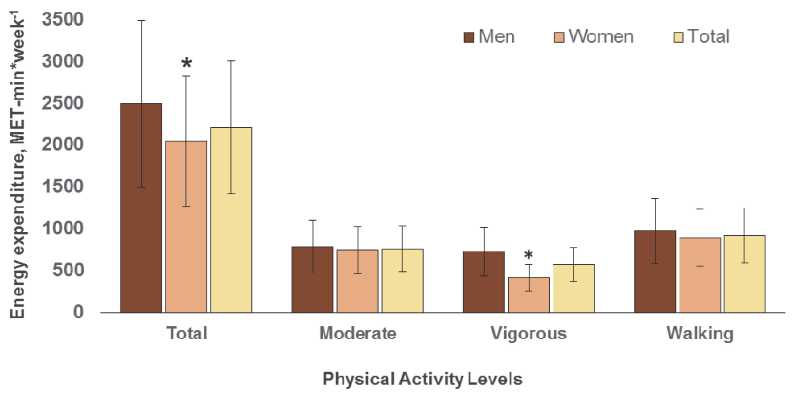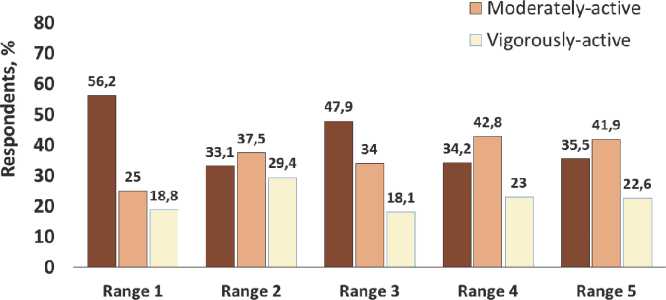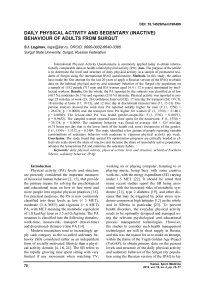Daily physical activity and sedentary (inactive) behaviour of adults from Surgut
Автор: Loginov S.I.
Журнал: Человек. Спорт. Медицина @hsm-susu
Рубрика: Спортивная тренировка
Статья в выпуске: 4 т.19, 2019 года.
Бесплатный доступ
International Physical Activity Questionnaire is commonly applied today to obtain internationally comparable data on health-related physical activity (PA). Aim. The purpose of the article is to determine the level and structure of daily physical activity in a sample of permanent residents of Surgut using the international IPAQ questionnaire. Methods. In this study, the author have made the first attempt for the last 20 years to apply a Russian version of the IPAQ to obtain data on the habitual physical activity and sedentary behavior of the Surgut city population on a sample of 1552 people (717 men and 835 women aged 34.4 ± 12.6 years) dominated by intellectual workers. Results. On the whole, the PA reported by the subjects was classified as of low (40.7 %), moderate (36.3 %) and vigorous (23.0 %) intensity. Physical activity was reported to average 25 min/day at work (23; 26 Confidence Interval [CI]); 17 min/day for transport (16; 19 CI); 18 min/day at home (17, 19 CI); and 12 min/ day at discretional (leisure) time (11, 13 CI). Dispersion analysis showed the work time PA reported notably higher for men (F (1, 1550) = = 26.676, p = 0.0000) and the transport time PA higher for women (F (1, 1550) = 21.801, p = 0.0000). The leisure-time PA was found gender-unspecific: F (1, 1550) = 0.00191, p = 0.9652). The sampled women reported more time spent for the housework: F (1, 1550) = 39.338, p = 0.0000. The sedentary behavior was found to average 405 ± 125 min/day (6.75 hours per day that is the lower limit of the health risk zone) irrespective of the gender: F (1, 1550) = 1.3332, p = 0.2484. The study identified a few groups of people reporting variable combinations of sedentary behavior with moderate to vigorous physical activity per week. Conclusion. The study found that special PA optimization programs are critically needed to effectively scale down the share of inactive and increase the share of reasonably active population, advance the leisure-time PA and minimize the sedentary habits.
Daily physical activity, physical activity level and structure, urbanized northernsiberia, sedentary behavior, ipaq
Короткий адрес: https://sciup.org/147233546
IDR: 147233546 | УДК: 796.012.4 | DOI: 10.14529/hsm190409
Текст научной статьи Daily physical activity and sedentary (inactive) behaviour of adults from Surgut
Physical activity (PA) levels and structure are presently considered the important measures of biosocial human behavior [2, 15], that provide the primary means for solving the psychological and educational issue on how to lure more and more people into regular physical practices [16]. For practical purposes, the PA is now commonly classified into three levels as low (< 3 МЕТ), moderate (3–6 МЕТ) and vigorous (> 6 МЕТ) PA, with МЕТ meaning the metabolic equivalent of 1.0 kcal/kg/ hour or 3.5 ml О 2 /kg/min. The PA structure is classified into the following domains: work-time, housework, transport (travel-time) and discretional- (leisure-) time PA [14].
Modern researchers tend to increasingly apply such category as the so-called sedentary behavior (SB) considered rather as an independent form of socially motivated lifestyle than a physical activity domain [4, 18, 24]. The SB refers to the rapidly growing time spent sitting with very limited if any movement when watching TV, working on or playing computer, listening to or playing music, being busy with some creative work etc., with the energy expenditure (EE) varying under 1.5 МЕТ [22]. It should be noted that many recent studies report the SB being associated with the increased risks of metabolic syndrome [21], type 2 diabetes [19], and other diseases that may be triggered by polar stress syndrome common at high latitudes [12] on the whole and in Siberia in particular [23]. To prevent health disorders, the everyday physical activity needs to be optimally designed and managed using the relevant psychological and educational process management technologies. However, the studies to consider such health management technologies are still in short supply in Russia, and this was the reason for us to make an attempt, within the frame of the Yugra Golden Age Project (YuGAP), to obtain primary data on the present levels and structure of the daily physical activity and sedentary behavior of the Surgut city population using the Russian version of the IPAQ to lay a basis for the psychological and educational process management technologies being applied to optimize the everyday physical activity.
Materials and methods
A random sample of 1152 residents of Surgut city including 717 men aged 32.8 ± 12.7 years (36.0 %) and 835 women aged 35.9 ± 12.4 years (64.0 %) was studied. Every subject was requested to self-report his/her PA using the long form (LF) of the IPAQ [17]. The IPAQ form is designed to obtain data on the time and energy costs of the PA leveled by low, moderate and vigorous PA additionally classified into four domains: work-time, transportation-time, housework and leisure-time PA. Every respondent was requested to recall and report the individual PA for the last 7 days in days, hours and minutes. The primary data obtained were processed as required by the standard format of the base English version of the IPAQ [3]. For the purposes of further analyses, the following intensity levels were applied: (1) low-intensity PA (LIPA < 1.52 МЕТ), (2) moderate-intensity PA (MIPA 3–6 МЕТ); and vigorous-intensity PA (VIPA > 7 МЕТ). The inactive people of predominantly sedentary behavior reporting PA under 10 min/day (< 60 МЕТ min/week) were classified under a separate category. Then the specific energy expenditure (EE) was calculated for every PA category as provided by the PA Compendium [1]. The specific energy expenditure (EE) was calculated by multiplying the time spent for the PA domain per day on the relevant cost of metabolic equivalent (MEТ) under this domain. The total energy expenditure (TEE) was found by summation of the PA-category-specific EE and expressed in МЕТ (further details may be found at . We applied a computer software of our own design to process and analyze the PA data.
The obtained data arrays were statistically processed using the Statistica 10 (StatSoft, USA) software toolkit. We computed the mean arith- metic value
Results
In late 2014 to early 2016, we questioned in total 1640 randomly sampled residents of Surgut city, with 65 women and 23 men being excluded from the data arrays for different reasons. The final sample totaled 1552 respondents including 717 men aged 32.8 ± 12.7 years (36.0 %) and 835 women aged 35.9 ± 12.4 years (64.0 %): see Table 1. On the whole the table shows the subject men having significantly bigger weight and taller than the women and reporting the higher PA-related weekly energy expenditures.
Professional groups – including the education sector, office personnel, technical personnel (laborers) of different industries and companies, and students – were represented in the Surgut population sample by virtually equal shares varying from 19.14 % (office personnel) to 24.23 % (students): see Table 2.
The only exception was found for the health sector personnel (dominated by physicians and hospital nurses) and pensioners that made up 6.96 % and 6.76 % of the sample, respectively. However, the last two categories are minor in the Surgut population and, hence, the sample may be considered representative of the whole healthsector and retired population of the city. The study found that the specific work-related energy expenditures (EE) reported by men were signifi-
Table 1
Anthropological data of the sampled Surgut residents, X ± SD
|
Variables |
Men (n = 717) |
Women (n = 835) |
Overall (n = 1552) |
|
Age, years |
34,8 ± 12,4 |
34,1 ± 12,3 |
34,45 ± 12,3 |
|
Body height, cm |
169,4 ± 8,4* |
164,5 ± 6,3 |
169,4 ± 8,4 |
|
Body mass, kg |
71,7 ± 14,3* |
65,2 ± 11,94 |
71,7 ± 14,27 |
|
Body mass index, kg/m2 |
25,6 ± 3,8* |
24,1 ± 4,3 |
24,9 ± 4,2 |
|
Energy expenditure, kcal/week |
2407 ± 2094* |
2087 ± 1740 |
2235 ± 1918 |
Note: *gender-specific difference at p < 0.05.
cantly higher (p < 0.05; t-test) than the women’s EE, whilst the latter reported spending more energy on the housework (p < 0.05; t-test) and transportation (p < 0.0001; t-test).
The study data showed no statistically significant gender-specific differences in the leisuretime PA data reported by the Surgut sample, see Figure 1.
Women reported higher specific energy expenditures on moderate PA than men, albeit the latter showed statistically higher vigorous PA rates. The study found no significant differences in the reported total PA and walking-related PA: see Figure 2.
Given on Figure 3 hereunder are the ranged sedentary behaviors by activity categories of the people subject to the IPAQ. The study data are indicative of the low-active subjects mostly grouping in Range 1 and Range 3 with 56.2 % reporting the sitting times of up to 3 hours per day; and 47.9 % of the low-active subjects reporting the sitting times of 6–9 hours per day. The vigorously-active subjects are found mostly grouped in Range 2 with their reported sitting times of 3–6 hours per day.
It may be pertinent to note the extremely high shares of moderately-active individuals falling in the sitting time ranges 4 and 5 (42.8 % and 41.9 %, respectively) making 9–15 hours per day. It means that the sample of permanent Surgut residents was found to include a significant proportion of the people combining moderate physical activity with long sedentary behavior on a weekly basis.
The single-factor dispersion analysis (analysis of variations, ANOVA) showed the work-related PA reported higher by men: F (1, 1550) = = 26.676, p = 0.0000; and the transportation-related PA by women: F (1, 1550) = 21.801, p = = 0.0000. The leisure-time PA was found gender-
Table 2
Sample breakdown by professional categories
|
Categories |
Women |
Men |
Overall |
|||
|
n |
% |
n |
% |
n |
% |
|
|
Education sector |
187 |
12,05 |
168 |
10,82 |
355 |
22,87 |
|
Office personnel |
163 |
10,5 |
134 |
8,63 |
297 |
19,14 |
|
Students |
216 |
13,92 |
160 |
10,31 |
376 |
24,23 |
|
Laborers |
142 |
9,15 |
169 |
10,89 |
311 |
20,04 |
|
Health sector personnel |
65 |
4,19 |
43 |
2,77 |
108 |
6,96 |
|
Pensioners |
62 |
3,99 |
43 |
2,77 |
105 |
6,76 |
|
Total |
835 |
53,8 |
717 |
46,2 |
1552 |
100 |

Physical Activity Domains
Fig. 1. Classified weekly energy expenditures (EE) on physical activity reported by the sampled Surgut men (n = 717) and women (n = 835) subject to the IPAQ, in МЕТ-min/ week, (X ± SD)

Fig. 2. Classified weekly energy expenditures (EE) on physical activity reported by the sampled Surgut men (n = 717) and women (n = 835) subject to the IPAQ, in МЕТ-min/ week, (X ± SD)* significant difference with p < 0.05
■ Low-active

Sedentary Time Ranges, min* day 1
Fig. 3. Physical activity levels versus the ranged sitting times (min/ day, n = 1552)
unspecific with F (1, 1550) = 0.00191, p = 0.9652. The women reported higher energy expenditures for housework making up F (1, 1550) = 39.338, p = 0.0000. The sedentary time was reported to average 2835.3 ± 874.2 min/ week (6.75 hours per day) being gender-unspecific with F (1, 1550) = = 1.3332, p = 0.2484.
Discussion
Positive effects of a moderate-intensity physical activity on human health are well known and commonly recognized today [9]. However, the problem of unorganized population being engaged in everyday physical activity reasonably necessary for health protection still remains largely unsolved. It has lately been aggravated by one more problem of the growing and largely inevitable sedentary behavior that – even when combined with periodical physical activity re- gardless of its intensity – may be highly detrimental for health [5]. A recent meta-analytical study report demonstrated that every extra inactive hour above 7 inactive (sitting) hours per day increases the death risk (irrespective of the causes) by 2 % for the otherwise active adults and by 5 % for the totally inactive ones [6]. It is commonly believed today that the moderate PA taking 60–75 min per day decreases albeit never excludes the increased risk of death due to habitual long sitting, particularly for the people watching TV for more than 5 hours per day [8]. Furthermore, there are study data to confirm that the long daily sitting times habitual for the adults diagnosed with high risks of type 2 diabetes are more detrimental for their cardio-metabolic health conditions and more influential on the latter than whatever physical activity they may otherwise resort to [10]. Therefore, modern health protection initiatives should be designed so as to reasonably combine the actions to increase the physical activity with the strategies to minimize the inactive/ sedentary behavior as these actions are equally important and interrelated [20].
The study presents the survey data for the Surgut population mostly engaged in the local services and non-industrial production sector and, hence, the sample is relatively homogenous. We are going to report our study data on the petroleum, construction and energy sector personnel’s PA and SB in a special upcoming report.
Our measurements under the present study resulted in the total PA of the Surgut residents surveyed – as verified by the total МЕТ-minutes per day for the 5 standard PA domains as per the IPAQ (i.e. the work-time, transportation-time, housework and leisure-time PA) – estimated at 1874 (1798, 1949 CI) МЕТ-minutes per week. This figure is notably lower than those reported by the Norwegian [11] and Croatian [5] respondents: 4240 (2155, 8916) МЕТ-min/ week and 3492 (3174, 3810) МЕТ-min/ week, respectively; albeit quite comparable with the one reported by the Swedish sample: 1536 (861, 2856) МЕТ-min/ week [7]. The Canadian adults from Ontario region reported their weekly physical activity at 4672 (SD 3551) МЕТ-min / week including vigorous- and moderate-intensity PA of 1389 (SD 1878) and 1378 (SD 1591) МЕТ-min / week, respectively. The Surgut respondents reported the vigorous, moderate and leisure-time PA at 240 (SD 578), 663 (SD 824) и 397 (361, 433) МЕТ-min/ week, respectively, that is by far lower than even the Canadian ones [10].
The increasingly common sedentary habits have been subject for many experimental and theoretical studies for the last few years. According to a large-scale physical activity survey conducted in 32 European nations, the average ac- tive-day sitting time was estimated at 309 minutes (5.25 hours) per day (SD 185), with the countryspecific sitting times varying from 236 min / day in Portugal to as much as 335–407 min/ day in Germany, Benelux Union and Scandinavian countries [3]. The Canadians who live in much the same climatic conditions, report the sitting times averaging 324 (SD 122) min / day versus 405 (SD 125) min / day reported by the Surgut adults. Curiously enough, the Finnish adults, as reported by the relevant accelerometer study, spend sitting about 60 % of the wakeful-state time in combination with moderate PA in between the sleep and work times [13].
Therefore, the above data provide more evidence in support of reasonable and regular physical activity, particularly in view of the fact that the share of population engaged in predominantly sitting works and habits is rapidly increasing. Presently the sedentary behaviors in many European countries and Canada are reported to average around 5 hours per day, and many analysts tend to recommend it as a guiding health standard. Our study has found that the average sitting time of the Surgut sample comes to 6.75 hours per day that is notably higher than the European average. Special physical activity encouragement and optimization programs are critically needed today to scale down the inactive and increase the reasonably active shares of population, advance the leisure-time PA and minimize the sedentary behavior.
This work was carried out as part of a state assignment with financial support from the Department of Education and Youth Policy of the Khanty-Mansi Autonomous Region – Ugra “Development and implementation of new technological solutions to optimize physical activity and health, establishing patterns of the body's response to physical activity of different modality in the Khanty-Mansi Autonomous Region-Ugra”.
Список литературы Daily physical activity and sedentary (inactive) behaviour of adults from Surgut
- Ainsworth B.E., Haskell W.L., Herrmann S.D. et al. Compendium of Physical Activities: a Second Update of Codes and MET Values // Med Sci Sports Exerc, 2011, vol. 43, pp. 1575-1581. DOI: 10.1249/MSS.0b013e31821ece12
- Balsevich V.K. Ontokineziologiya cheloveka [Human Ontokineziology]. Moscow, Theory and Practice of Physical Culture Publ., 2000.
- Bennie J.A., Chau J.Y., van der Ploeg H.P., Stamatakis E., Do A., Bauman A. The Prevalence and Correlates of Sitting in European Adults - a Comparison of 32 Eurobarometer-Participating Countries // Int J BehavNutr Phys Act, 2013, vol. 11 (10), p. 107. DOI: 10.1186/1479-5868-10-107
- Bennie J.A., Pedisic Z., van Uffelen J.G., Gale J., Banting L.K., Vergeer I., Stamatakis E., Bauman A.E., Biddle S.J. A Systematic Review of Correlates of Sedentary Behaviour in Adults Aged 18-65 Years: A Socio-Ecological Approach // BMC Public Health, 2016, vol. 25 (16), p. 73. DOI: 10.1186/s12889-016-2736-3
- Bouchard C., Blair S.N., Katzmarzyk P.T. Less Sitting, More Physical Activity, or Higher Fitness? // Mayo Clin Proc, 2015, vol. 90 (11), pp. 1533-1540. DOI: 10.1016/j.mayocp.2015.08.005


